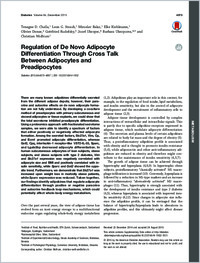Regulation of De Novo Adipocyte Differentiation Through Cross Talk Between Adipocytes and Preadipocytes.
- Challa TD Institute of Food, Nutrition and Health, ETH Zurich, Schwerzenbach, Switzerland.
- Straub LG Institute of Food, Nutrition and Health, ETH Zurich, Schwerzenbach, Switzerland.
- Balaz M Institute of Food, Nutrition and Health, ETH Zurich, Schwerzenbach, Switzerland.
- Kiehlmann E Institute of Food, Nutrition and Health, ETH Zurich, Schwerzenbach, Switzerland.
- Donze O Adipogen, Epalinges, Switzerland.
- Rudofsky G Kantonsspital Olten, Olten, Switzerland.
- Ukropec J Institute of Experimental Endocrinology, Slovak Academy of Sciences, Bratislava, Slovakia.
- Ukropcova B Institute of Experimental Endocrinology, Slovak Academy of Sciences, Bratislava, Slovakia Institute of Pathological Physiology, Comenius University, Bratislava, Slovakia.
- Wolfrum C Institute of Food, Nutrition and Health, ETH Zurich, Schwerzenbach, Switzerland christian-wolfrum@ethz.ch.
- 2015-09-06
Published in:
- Diabetes. - 2015
3T3-L1 Cells
Adipocytes
Adipogenesis
Adult Stem Cells
Animals
Body Mass Index
Cell Communication
Cell Size
Cells, Cultured
Coculture Techniques
Cohort Studies
Gene Expression Regulation, Developmental
HEK293 Cells
Humans
Male
Mice
Mice, Inbred C57BL
Obesity
RNA Interference
Recombinant Proteins
Specific Pathogen-Free Organisms
Subcutaneous Fat
Subcutaneous Fat, Abdominal
Tissue Culture Techniques
English
There are many known adipokines differentially secreted from the different adipose depots; however, their paracrine and autocrine effects on de novo adipocyte formation are not fully understood. By developing a coculture method of preadipocytes with primary subcutaneous and visceral adipocytes or tissue explants, we could show that the total secretome inhibited preadipocyte differentiation. Using a proteomics approach with fractionated secretome samples, we were able to identify a spectrum of factors that either positively or negatively affected adipocyte formation. Among the secreted factors, Slc27a1, Vim, Cp, and Ecm1 promoted adipocyte differentiation, whereas Got2, Cpq, interleukin-1 receptor-like 1/ST2-IL-33, Sparc, and Lgals3bp decreased adipocyte differentiation. In human subcutaneous adipocytes of lean subjects, obese subjects, and obese subjects with type 2 diabetes, Vim and Slc27a1 expression was negatively correlated with adipocyte size and BMI and positively correlated with insulin sensitivity, while Sparc and Got2 showed the opposite trend. Furthermore, we demonstrate that Slc27a1 was increased upon weight loss in morbidly obese patients, while Sparc expression was reduced. Taken together, our findings identify adipokines that regulate adipocyte differentiation through positive or negative paracrine and autocrine feedback loop mechanisms, which could potentially affect whole-body energy metabolism.
- Language
-
- English
- Open access status
- bronze
- Identifiers
-
- DOI 10.2337/db14-1932
- PMID 26340931
- Persistent URL
- https://folia.unifr.ch/global/documents/52411
Statistics
Document views: 24
File downloads:
- fulltext.pdf: 0
